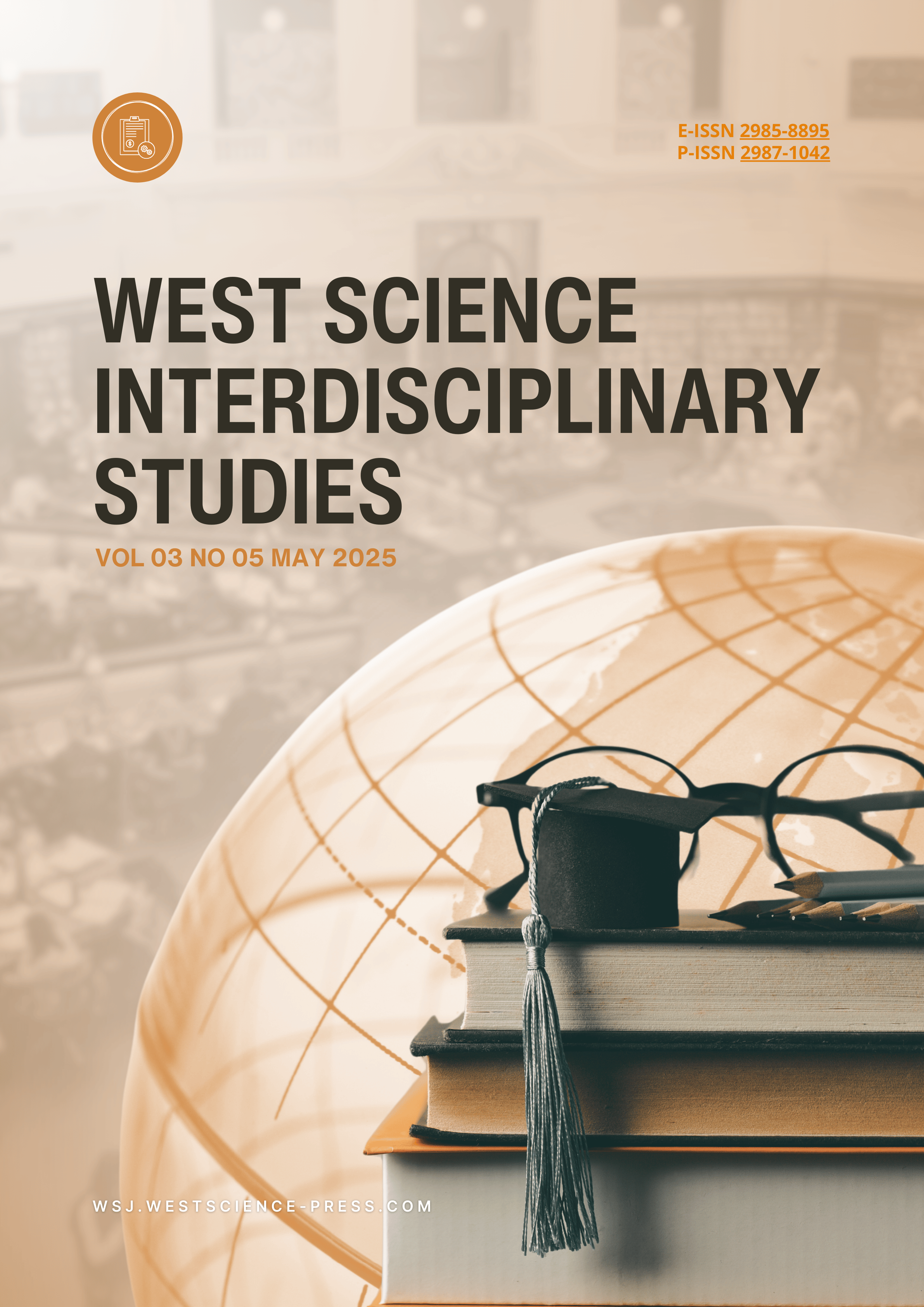Analysis of the Role of Export Risk Management and Financing Policy Effectiveness on the Competitiveness of the Agricultural Industry in Indonesia
DOI:
https://doi.org/10.58812/wsis.v3i05.1901Keywords:
Export Risk Management, Financing Policy Effectiveness, Competitiveness, Agricultural Industry, IndonesiaAbstract
This study investigates the role of export risk management and financing policy effectiveness in enhancing the competitiveness of Indonesia's agricultural industry. Using a quantitative approach, data were collected from 120 respondents, including stakeholders in the agricultural export sector, through a structured questionnaire employing a five-point Likert scale. The data were analyzed using SPSS version 25, with results indicating that both export risk management and financing policy effectiveness have significant positive impacts on competitiveness. Export risk management emerged as the stronger predictor, highlighting the importance of proactive strategies in mitigating trade risks. The combined influence of these factors explains 67% of the variance in competitiveness, underscoring their synergistic effect. The findings emphasize the need for policymakers and industry leaders to prioritize integrated risk management frameworks and enhance access to sector-specific financing solutions to support sustainable growth in agricultural exports.
References
[1] A. Rai and A. Faisal, “Daya Saing Komoditas Pertanian Unggulan Indonesia: Perbandingan Dengan Negara Lain Di Asean Dan Potensinya,” SEPA J. Sos. Ekon. Pertan. Dan Agribisnis, vol. 19, no. 1, pp. 72–81, 2022.
[2] S. Jagdambe, Analysis of export competitiveness of Indian agricultural products with ASEAN countries. Institute for Social and Economic Change, 2016.
[3] R. Feni, E. Marwan, E. Efrita, N. Kesumawati, and R. Efendi, “Analysis of the Role of Agribusiness in the Indonesian Economy,” Int. J. Soc. Sci. Res. Rev., vol. 7, no. 4, pp. 106–113, 2024.
[4] S. Marwanti and H. Irianto, “Pengaruh ekspor, impor, dan investasi terhadap pertumbuhan sektor pertanian Indonesia,” J. agro Ekon., vol. 35, no. 1, pp. 49–65, 2018.
[5] E. P. Astuti, R. Nurmalina, and A. Rifin, “The Competitiveness of Indonesian agricultural products in G-20 market,” Agro Ekon., vol. 33, no. 1, pp. 22–32, 2022.
[6] O. Binert, I. Sadovska, S. Begun, and T. Shmatkovska, “Mechanisms for improving economic relations in the milk subcomplex of the agricultural sector: a case study of Ukraine,” 2021.
[7] A. S. S. F. da Costa, “Financial risk management in agriculture: mitigation strategies and protection against economic variables,” Int. J. Sci. Manag. Tour., vol. 10, no. 4, pp. e1045–e1045, 2024.
[8] B. Breen, T. Hennessy, T. Donnellan, and K. Hanrahan, “Tools and polices for agricultural risk management,” 2013.
[9] J. Anton, “Risk Management in Agriculture: What Role for Governments?,” 2012.
[10] H. M. Harris, G. A. Benson, and C. P. Rosson, “Managing risk in a dynamic world economy,” 1999.
[11] S. Sahara, N. A. Putri, and R. R. Aulia, “Penciptaan Gelas Sekali Pakai Mudah Terurai dengan Pemanfaatan Ampas Teh Menggunakan Metode Eksperimen,” Ranah Res. J. Multidiscip. Res. Dev., vol. 6, no. 5, pp. 1499–1506, 2024.
[12] N. Ashari, “Peran perbankan nasional dalam pembiayaan sektor pertanian di Indonesia,” in Forum Penelitian Agro Ekonomi, 2009, pp. 13–27.
[13] R. Shrestha and I. Coxhead, “Can Indonesia secure a development dividend from its resource export boom?,” Bull. Indones. Econ. Stud., vol. 54, no. 1, pp. 1–24, 2018.
[14] G. K. Dzhancharova, B. K. Bolaev, and K. M. S. Murtazova, “Research of Russian meat export to the Chinese market,” in IOP Conference Series: Earth and Environmental Science, IOP Publishing, 2021, p. 12187.
[15] M. HRYHORAK, “TRANSFORMATION OF LOGISTICS ACTIVITIES OF INDUSTRIAL ENTERPRISES IN THE TRANSITION TO INDUSTRY 5.0.,” Mykhailo OKLANDER, p. 132.
[16] V. Choudhary et al., “Agricultural sector risk assessment: methodological guidance for practitioners,” The World Bank, 2016.
[17] K. Liu and Q. Fu, “Does geopolitical risk affect agricultural exports? Chinese evidence from the perspective of agricultural land,” Land, vol. 13, no. 3, p. 371, 2024.
[18] J.-M. Puel, “Are Sovereign Wealth Funds’ Investments in Agriculture Political?,” Etud. Rurales, vol. 190, no. 2, pp. 161–176, 2012.
[19] P. J. Barry and L. J. Robison, “Agricultural finance: Credit, credit constraints, and consequences,” Handb. Agric. Econ., vol. 1, pp. 513–571, 2001.
[20] T. Havemann, C. Negra, and F. Werneck, “Blended finance for agriculture: exploring the constraints and possibilities of combining fi nancial instruments for sustainable transitions,” in Social innovation and sustainability transition, Springer, 2022, pp. 347–358.
[21] L. Vdovenko, “Activation of financial mechanisms in the system financial and credit security for the development of agricultural enterprises,” Publ. House “Baltija Publ., 2023.
[22] H. Bredrup, “Competitiveness and competitive advantage,” in Performance Management: A business process benchmarking approach, Springer, 1995, pp. 43–60.
[23] I. I. Doronina, V. N. Borobov, E. A. Ivanova, E. V Gorynya, and B. M. Zhukov, “Agro-industrial clusters as a factor of increasing competitiveness of the region,” Int. J. Econ. Financ. issues, vol. 6, no. 1, pp. 295–299, 2016.
[24] M. Gül and A. Bayav, “Anatomy of Competition in the Global Agricultural Market: A Cross-Country Comparative Analysis,” in E3S Web of Conferences, EDP Sciences, 2024, p. 2008.
[25] A. Jambor, S. Babu, A. Jambor, and S. Babu, “Strategies for increasing competitiveness of agriculture,” Compet. Glob. Agric. Policy Lessons Food Secur., pp. 151–171, 2016.
[26] S. Widiyanesti and Y. Fernando, “A Review of Supply Chain Risk Management in Agribusiness Industry,” Encycl. Inf. Sci. Technol. Fourth Ed., pp. 5550–5558, 2018.
[27] A. Profita, D. K. R. Kuncoro, and M. R. Baihaqi, “Designing Risk Mitigation Strategies for Agricultural Supply Chain: A Supply Chain Finance-Based Approach,” in IOP Conference Series: Earth and Environmental Science, IOP Publishing, 2024, p. 12045.
[28] A. Kusmiati, J. M. M. Aji, E. S. Hani, and K. Hariyono, “Enhancing supply chain resilience through risk mitigation strategies: Evidence from smallholder red chili supply chains in East Java Indonesia,” J. Infrastructure, Policy Dev., vol. 8, no. 10, 2024.
[29] T. R. Fauzan and A. S. Syara, “Integrating Supply Chain Risk Management and Organizational Agility in Post-pandemic Era: A Pathway to Superior MSMEs Performance in Indonesia,” TRANSEKONOMIKA AKUNTANSI, BISNIS DAN Keuang., vol. 5, no. 1, pp. 265–279, 2025.
[30] L. N. Faiza, A. Wardhono, and L. Yuliati, “The PRESCRIPTIVE ON THE IMPACT OF FINANCIAL DEVELOPMENT AND EXPORTS IN INDONESIA,” J. Ekuilibrium, vol. 8, no. 1, pp. 26–41, 2024.
[31] R. Y. Siregar, “Trade financing and export performance: Experiences of Indonesia, Korea and Thailand 1,” in Real and Financial Integration in Asia, Routledge, 2012, pp. 151–172.
[32] G. Onumah and G. W. Meijerink, “Innovative agricultural financing models,” 2012.
[33] S. H. Susilowati, “Kebijakan insentif untuk petani muda: Pembelajaran dari Berbagai Negara dan Implikasinya bagi Kebijakan di Indonesia,” in Forum Penelitian Agro Ekonomi, 2016, pp. 103–123.
Downloads
Published
Issue
Section
License
Copyright (c) 2025 Loso Judijanto, M Gifari Sono, Yana Priyana

This work is licensed under a Creative Commons Attribution-ShareAlike 4.0 International License.
























 Instagram
Instagram 